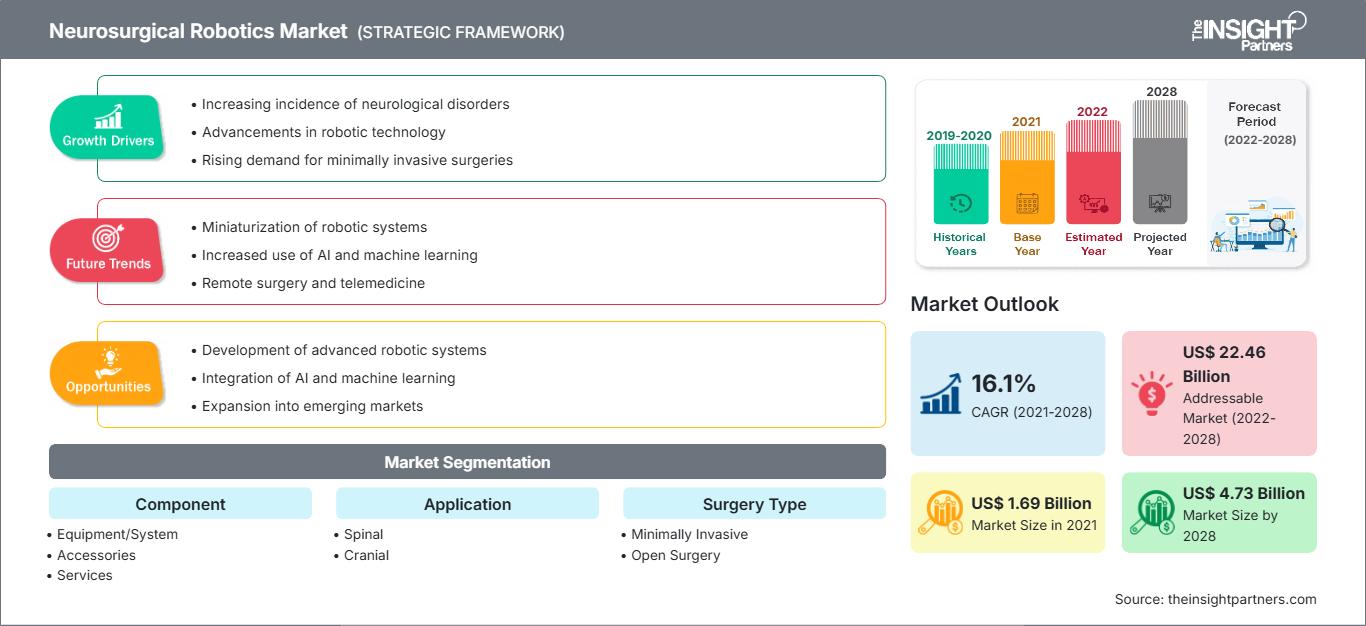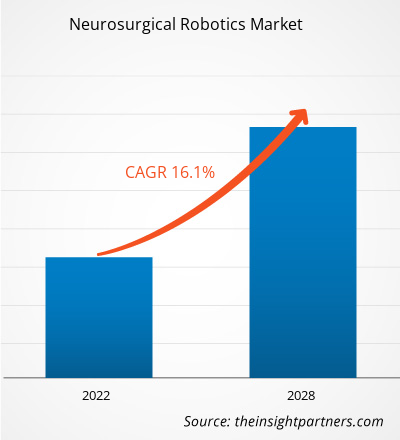Si prevede che il mercato della robotica neurochirurgica crescerà da 1.691,02 milioni di dollari nel 2021 a 4.729,86 milioni di dollari entro il 2028. Si stima una crescita a un CAGR del 16,1% dal 2022 al 2028.
Un robot è un dispositivo meccanico automatico che spesso assomiglia a un essere umano o a un animale. I robot moderni sono solitamente macchine elettromeccaniche guidate da un programma per computer o da circuiti elettronici. I robot possono essere autonomi o semi-autonomi e spaziano da umanoidi come l'Advanced Step in Innovative Mobility (ASIMO) di Honda e il TOSY Ping Pong Playing Robot (TOPIO) di TOSY a robot industriali, robot a sciame programmati collettivamente e persino nanorobot microscopici. Negli ultimi 20 anni, i robot neurochirurgici hanno assistito sempre più spesso nelle procedure neurochirurgiche. Negli ultimi anni, sono stati sviluppati robot neurochirurgici per eseguire diverse procedure. La domanda pubblica sta influenzando l'orientamento della neurochirurgia e sta esercitando una maggiore pressione sui neurochirurghi affinché utilizzino robot neurochirurgici. La crescente diversità e sofisticatezza dei robot neurochirurgici è stata oggetto di un esame etico a causa delle possibili complicazioni chirurgiche e del ruolo dei robot in futuro. Il rapporto offre approfondimenti e analisi approfondite del mercato globale della robotica neurochirurgica, evidenziando diversi parametri, tra cui tendenze di mercato, progressi tecnologici, dinamiche di mercato e analisi del panorama competitivo dei principali attori del mercato globale. Include anche l'impatto della pandemia di COVID-19 sul mercato in tutte le regioni. L'impatto complessivo del COVID-19 sul mercato della robotica neurochirurgica è stato eterogeneo; pertanto, il mercato sta ancora guadagnando terreno e si prevede che crescerà nei prossimi anni. I sistemi sanitari sono stati sovraccaricati e l'erogazione di assistenza medica a tutti i pazienti è diventata una sfida nella regione. Inoltre, anche il settore dei dispositivi medici ha dovuto affrontare l'impatto indesiderato di questa pandemia. Con il protrarsi della pandemia di COVID-19, le aziende produttrici di dispositivi medici hanno riscontrato difficoltà nella gestione delle proprie attività. Molte aziende di robotica neurochirurgica operavano negli Stati Uniti e hanno subito gli effetti negativi di un'epidemia diffusa di COVID-19. Tuttavia, dopo la normalizzazione delle restrizioni pandemiche, il volume degli interventi chirurgici è tornato alla normalità. Gli ospedali hanno gradualmente ripreso le procedure elettive, poiché il tasso di guarigione dal COVID-19 stava aumentando la domanda di apparecchiature mediche come i robot neurochirurgici.
Personalizza questo rapporto in base alle tue esigenze
Potrai personalizzare gratuitamente qualsiasi rapporto, comprese parti di questo rapporto, o analisi a livello di paese, pacchetto dati Excel, oltre a usufruire di grandi offerte e sconti per start-up e università
Mercato della robotica neurochirurgica: Approfondimenti strategici

-
Ottieni le principali tendenze chiave del mercato di questo rapporto.Questo campione GRATUITO includerà l'analisi dei dati, che vanno dalle tendenze di mercato alle stime e alle previsioni.
Approfondimenti basati sulla geografia
In base alla geografia, il mercato globale della robotica neurochirurgica è segmentato in Nord America (Stati Uniti, Canada e Messico), Europa (Francia, Germania, Regno Unito, Spagna, Russia, Italia e resto d'Europa), Asia Pacifico (Cina, India, Giappone, Australia, Corea del Sud, Kazakistan e resto dell'APAC), Medio Oriente e Africa (Arabia Saudita, Emirati Arabi Uniti, Sudafrica e resto dell'area MEA) e Sud e Africa. America Centrale (Brasile, Argentina e resto dell'America meridionale e centrale).
Approfondimenti di mercato
Aumento del numero di interventi neurochirurgici
La crescente prevalenza di disturbi neurologici, tra cui epilessia, morbo di Parkinson, traumi cranici, tumori cerebrali, ictus cerebrale e idrocefalo, aumenta la necessità di interventi neurochirurgici. Inoltre, diverse sottospecialità della neurochirurgia, come la neurochirurgia pediatrica, la neurochirurgia funzionale, la chirurgia neurovascolare, la traumatologia, la chirurgia della base cranica e la chirurgia spinale, sono tra le aree chirurgiche più tecniche e qualificate.
Secondo un articolo intitolato "Emphasizing the Role of Neurosurgery Within Global Health and National Health Systems" Pubblicato su Frontiers Media SA nel 2021, a causa della crescente incidenza di lesioni cerebrali traumatiche (TBI) e idrocefalo, 22,6 milioni di persone in tutto il mondo necessitano ogni anno di cure neurologiche. Tra questi pazienti, 13,8 milioni necessitano di interventi neurochirurgici. Secondo i dati pubblicati dai Centers for Disease Control and Prevention (CDC), gli Stati Uniti hanno registrato circa 223.135 ricoveri ospedalieri correlati a TBI nel 2019 e 64.362 decessi correlati a TBI nel 2020. Inoltre, secondo un articolo pubblicato nel 2022 su The Lancet intitolato "The future research path of traumatic brain injury", ogni anno vengono segnalati in tutto il mondo oltre 27 milioni di nuovi casi di TBI. Il TBI può essere trattato con procedure neurochirurgiche. Pertanto, l'aumento dei casi di TBI dovuto a diversi fattori, tra cui cadute, infortuni sportivi, incidenti stradali, violenza domestica e incidenti militari, aumenta la domanda di procedure neurochirurgiche.
Secondo i dati dell'Organizzazione Mondiale della Sanità (OMS) pubblicati a giugno 2022, circa 50 milioni di persone soffrono di epilessia in tutto il mondo, una delle malattie neurologiche più comuni. Quasi l'80% dei pazienti epilettici vive in paesi a basso e medio reddito. Inoltre, Si stima che ogni anno a 5 milioni di persone venga diagnosticata l'epilessia. I pazienti che rispondono male al trattamento farmacologico vengono sottoposti a intervento chirurgico. Pertanto, la crescente incidenza dell'epilessia aumenta la necessità di procedure neurochirurgiche. Pertanto, l'aumento del numero di interventi neurochirurgici guida la crescita del mercato della robotica neurochirurgica.
Approfondimenti basati sui componenti
In base ai componenti, il mercato globale della robotica neurochirurgica è segmentato in apparecchiature, accessori e servizi. Nel 2021, il segmento degli accessori ha rappresentato la quota di mercato maggiore. Tuttavia, si prevede che il segmento dei servizi registrerà il CAGR più elevato del mercato dal 2022 al 2028.
Approfondimenti basati sulle applicazioni
In base all'applicazione, il mercato globale della robotica neurochirurgica è suddiviso in spinale e cranico. Il segmento spinale ha detenuto una quota di mercato maggiore nel 2021 e si prevede per registrare un CAGR più rapido durante il periodo di previsione.
Mercato della robotica neurochirurgicaLe tendenze regionali e i fattori che influenzano il mercato della robotica neurochirurgica durante il periodo di previsione sono stati ampiamente spiegati dagli analisti di The Insight Partners. Questa sezione illustra anche i segmenti e la geografia del mercato della robotica neurochirurgica in Nord America, Europa, Asia-Pacifico, Medio Oriente e Africa, America meridionale e centrale.
Ambito del rapporto di mercato sulla robotica neurochirurgica
| Attributo del rapporto | Dettagli |
|---|---|
| Dimensioni del mercato in 2021 | US$ 1.69 Billion |
| Dimensioni del mercato per 2028 | US$ 4.73 Billion |
| CAGR globale (2021 - 2028) | 16.1% |
| Dati storici | 2019-2020 |
| Periodo di previsione | 2022-2028 |
| Segmenti coperti |
By Componente
|
| Regioni e paesi coperti |
Nord America
|
| Leader di mercato e profili aziendali chiave |
|
Densità degli operatori del mercato della robotica neurochirurgica: comprendere il suo impatto sulle dinamiche aziendali
Il mercato della robotica neurochirurgica è in rapida crescita, trainato dalla crescente domanda degli utenti finali, dovuta a fattori quali l'evoluzione delle preferenze dei consumatori, i progressi tecnologici e una maggiore consapevolezza dei benefici del prodotto. Con l'aumento della domanda, le aziende stanno ampliando la propria offerta, innovando per soddisfare le esigenze dei consumatori e sfruttando le tendenze emergenti, alimentando ulteriormente la crescita del mercato.

- Ottieni il Mercato della robotica neurochirurgica Panoramica dei principali attori chiave
Informazioni basate sull'utente finale
In base agli utenti finali, il mercato globale della robotica neurochirurgica è segmentato in ospedali, centri specialistici e altri. Il segmento ospedaliero ha detenuto la quota di mercato maggiore nel 2021. Si prevede che lo stesso segmento registrerà il CAGR più elevato del mercato dal 2022 al 2028.
Gli operatori del mercato globale della robotica neurochirurgica adottano strategie organiche, tra cui il lancio e l'espansione di prodotti, per espandere la propria presenza e il portafoglio prodotti in tutto il mondo e soddisfare la crescente domanda. I principali attori del mercato sono Globus Medical, Inc., Renishaw plc, Accuray Incorporated, NuVasive, Inc, Brainlab AG, Zimmer Biomet, Synaptive Medical, Inc., Medtronic, Brain Navi Biotechnology Co., Ltd., B. Braun Melsungen AG.
- Analisi storica (2 anni), anno base, previsione (7 anni) con CAGR
- Analisi PEST e SWOT
- Valore/volume delle dimensioni del mercato - Globale, Regionale, Nazionale
- Industria e panorama competitivo
- Set di dati Excel
Report recenti
Rapporti correlati
Testimonianze
Motivo dell'acquisto
- Processo decisionale informato
- Comprensione delle dinamiche di mercato
- Analisi competitiva
- Analisi dei clienti
- Previsioni di mercato
- Mitigazione del rischio
- Pianificazione strategica
- Giustificazione degli investimenti
- Identificazione dei mercati emergenti
- Miglioramento delle strategie di marketing
- Aumento dell'efficienza operativa
- Allineamento alle tendenze normative






















 Ottieni un campione gratuito per - Mercato della robotica neurochirurgica
Ottieni un campione gratuito per - Mercato della robotica neurochirurgica